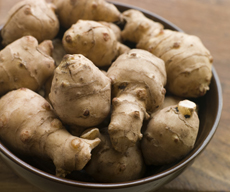Red Rice Grain Bowl Recipe, Gluten Free, Whole Grain
|
Of all the international foods that have become mainstream in the U.S., some lovely rice varieties from Asia remain largely unknown. When we want to add something extra to a dish, we often replace the white or brown rice with red rice of black rice. As with brown rice, red and black are whole grain.
Red rice is an unhulled or partially hulled rice variety that has a red husk (most rice has a brown husk). The rice grains are also red in color. As an unhulled rice, red rice has a nutty flavor from the bran (like brown rice) and high nutritional value from the germ. The nutrition and fiber roughly compare to brown rice, as are the cooking proportions: 2 cups of fluids per cup of rice. The red color comes from anthocyanins, powerful antioxidants that create red, blue and purple colors. They give color to radicchio, red onions, red/purple cabbage and purple potatoes, among other foods. A red rice grain and sunchokebowl recipe is below. As with all agricultural products, there are numerous varieties of red rice: More than 2,000 rice varieties are grown throughout the world. Depending on the variety, red rice can be long or short grain. The grain grows well in both high elevations, such as Kingdom of Bhutan in the eastern Himalayas and the Palakkad District of the Indian state of Kerala, and low elevations including the wetlands of the Camargue region of southern France, and cargo red rice from Thailand. The varieties you are most likely to find in the U.S. include: |
 [1] Himalayan Red Rice (photo © Olive Nation).
|
|
|
RECIPE: RED RICE & SUNCHOKE GRAIN BOWL This savory grain bowl uses ingredients that may not be part of your regular grocery list: red rice, sunchokes (formerly called Jerusalem artichokes), beet greens and the Middle Eastern spice, sumac. The recipe is from Good Eggs, with the note: “This recipe is a great reminder to treat beet greens as a valuable vegetable in their own right. Once you see how much flavor they add to this bowl, you’ll never compost them again!” TIP: Beet greens are “free” when you buy fresh beets. Some people who buy beets at farmers markets ask the farmer to remove the tops (the beet greens) so they don’t have to do it at home. Seek out the nearest beet seller and ask him/her for the tops. If you don’t want to seem like you want something for nothing, say they’re for your rabbits. Prep time for this recipe is 15 minutes, active time is 35 minutes total. |
||
 [4] A nutritious, delicious grain bowl from Good Eggs, focusing on red rice and beet greens (photo © Good Eggs).
|
Ingredients For 2-3 Servings *An easy substitute for sumac is lemon zest plus salt. In salads, use lemon juice or vinegar. Sumac is ground from a red berry-like drupe that grows in clusters on bushes in subtropical and temperate regions. The dried drupes of some species are ground to produce sumac, a tangy, crimson spice. The word “sumac” comes from the old Syriac Aramaic summaq, meaning red. In Middle Eastern cuisine, the spice is used to add a tangy, lemony taste to meats and salads; and to garnish hummus and rice. The spice is also a component of the popular spice blend, za’atar. 1. PREHEAT the oven to 375°F. While the oven heats up… 2. ADD a cup of red rice to a pot with two cups of water. Bring to a boil over high heat. When the rice and water are at a rolling boil, cover the pot and turn down to a simmer for about 20 minutes. When all of the water has been absorbed… 3. REMOVE the pot from the heat, add the cumin and allow it to sit and steam with the lid on for about 10 minutes. After 10 minutes, fluff the rice with a fork. While the rice cooks… |
|
|
4. TOSS the sunchoke slices with a a tablespoon of olive oil (more if needed) and the rosemary, and spread in a single layer on a baking sheet. Bake for about 20 minutes, until the sunchokes start to turn golden brown and their edges are crispy. 5. HEAT 2-3 tablespoons of olive oil in a small pan. When the oil is hot, add the shallots and cook for about 3 minutes, until the shallots start to turn golden brown and translucent. Add the beet greens at this point and turn the heat to medium. Turn with tongs to distribute the shallots and olive oil. Cook the greens until they’re tender—7-10 minutes—and finish with a tablespoon of lime juice. 6. ASSEMBLE the bowl. Start with a base of rice and add the greens and sunchokes. Add a dollop of Greek yogurt and sprinkle the sumac on the yogurt. Finish with a handful of scallions, a sprinkle of flake salt and freshly ground black pepper. |
||





